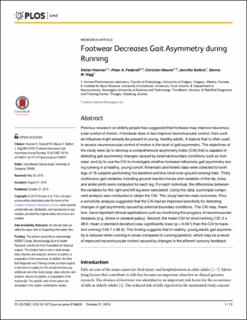| dc.contributor.author | Hoerzer, Stefan | |
| dc.contributor.author | Federolf, Peter Andreas | |
| dc.contributor.author | Maurer, Christian | |
| dc.contributor.author | Baltich, Jennifer | |
| dc.contributor.author | Nigg, Benno M. | |
| dc.date.accessioned | 2020-03-19T09:46:31Z | |
| dc.date.available | 2020-03-19T09:46:31Z | |
| dc.date.created | 2016-02-24T13:48:25Z | |
| dc.date.issued | 2015 | |
| dc.identifier.issn | 1932-6203 | |
| dc.identifier.uri | http://hdl.handle.net/11250/2647510 | |
| dc.description.abstract | Previous research on elderly people has suggested that footwear may improve neuromuscular control of motion. If footwear does in fact improve neuromuscular control, then such an influence might already be present in young, healthy adults. A feature that is often used to assess neuromuscular control of motion is the level of gait asymmetry. The objectives of the study were (a) to develop a comprehensive asymmetry index (CAI) that is capable of detecting gait asymmetry changes caused by external boundary conditions such as footwear, and (b) to use the CAI to investigate whether footwear influences gait asymmetry during running in a healthy, young cohort. Kinematic and kinetic data were collected for both legs of 15 subjects performing five barefoot and five shod over-ground running trials. Thirty continuous gait variables including ground reaction forces and variables of the hip, knee, and ankle joints were computed for each leg. For each individual, the differences between the variables for the right and left leg were calculated. Using this data, a principal component analysis was conducted to obtain the CAI. This study had two main outcomes. First, a sensitivity analysis suggested that the CAI had an improved sensitivity for detecting changes in gait asymmetry caused by external boundary conditions. The CAI may, therefore, have important clinical applications such as monitoring the progress of neuromuscular diseases (e.g. stroke or cerebral palsy). Second, the mean CAI for shod running (131.2 ± 48.5; mean ± standard deviation) was significantly lower (p = 0.041) than the CAI for barefoot running (155.7 ± 39.5). This finding suggests that in healthy, young adults gait asymmetry is reduced when running in shoes compared to running barefoot, which may be a result of improved neuromuscular control caused by changes in the afferent sensory feedback. | nb_NO |
| dc.language.iso | eng | nb_NO |
| dc.publisher | Public Library of Science | nb_NO |
| dc.rights | Navngivelse 4.0 Internasjonal | * |
| dc.rights.uri | http://creativecommons.org/licenses/by/4.0/deed.no | * |
| dc.title | Footwear decreases gait asymmetry during running | nb_NO |
| dc.type | Journal article | nb_NO |
| dc.type | Peer reviewed | nb_NO |
| dc.description.version | publishedVersion | nb_NO |
| dc.source.volume | 10:e0138631 | nb_NO |
| dc.source.journal | PLOS ONE | nb_NO |
| dc.source.issue | 10 | nb_NO |
| dc.identifier.doi | 10.1371/journal.pone.0138631 | |
| dc.identifier.cristin | 1339697 | |
| dc.description.localcode | © 2015 Hoerzer et al. This is an openaccess article distributed under the terms of theCreative Commons Attribution License, which permitsunrestricted use, distribution, and reproduction in anymedium, provided the original author and source arecredited. | nb_NO |
| cristin.unitcode | 194,65,30,0 | |
| cristin.unitname | Institutt for nevromedisin og bevegelsesvitenskap | |
| cristin.ispublished | true | |
| cristin.fulltext | original | |
| cristin.qualitycode | 1 | |

